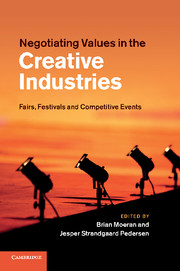Book contents
- Frontmatter
- Contents
- Figures
- Tables
- Contributors
- Acknowledgements
- Introduction
- 1 A Salon’s life
- 2 Art fairs
- 3 Biennalization and its discontents
- 4 Staging auctions
- 5 The book fair as a tournament of values
- 6 Inventing universal television
- 7 Transforming film product identities
- 8 Event institutionalization and maintenance
- 9 Tradition and transformation at the Fan Fair festival
- 10 Between art and commerce
- 11 Configuring sustainability at fashion week
- 12 An inconvenient truce
- 13 The retrospective use of tournament rituals in field configuration
- Afterword Converting values into other values
- Author index
- Subject index
- References
12 - An inconvenient truce
cultural domination and contention after the 1855 Médoc wine classification event
Published online by Cambridge University Press: 25 October 2011
- Frontmatter
- Contents
- Figures
- Tables
- Contributors
- Acknowledgements
- Introduction
- 1 A Salon’s life
- 2 Art fairs
- 3 Biennalization and its discontents
- 4 Staging auctions
- 5 The book fair as a tournament of values
- 6 Inventing universal television
- 7 Transforming film product identities
- 8 Event institutionalization and maintenance
- 9 Tradition and transformation at the Fan Fair festival
- 10 Between art and commerce
- 11 Configuring sustainability at fashion week
- 12 An inconvenient truce
- 13 The retrospective use of tournament rituals in field configuration
- Afterword Converting values into other values
- Author index
- Subject index
- References
Summary
Cultural domination in fields is often thought to favour uniformity, homogeneity and stability at the field level, and conformity and compliance at the actor level. Field domination emerges over time with the stabilization of an unambiguous hierarchy and is associated with an increasing institutionalization, structuration and ordering that occur mostly through the deployment of isomorphic pressures (DiMaggio and Powell, 1983). At the actor level, this process results in conformity to the hierarchy, the alignment of meanings, expectations and behaviour of field members; it tends to increase consensus, decrease ambiguity and inhibit contention and contestation. Conversely, fields without a dominant hierarchy are associated with diversity and heterogeneity at the field level, and contention and contestation at the actor level. This lack of domination results from the distribution of authority sources among multiple legitimate bodies and an overlap of institutional pressures with which to comply. It leads to the co-existence of multiple meanings, expectations and behaviour about what counts in a field; it also tends to increase contention and raise the degree of ambiguity and complexity. In sum, viewed a-historically, the greater the domination there is at a field level, the lower the amount of contention one observes at the actor level.
In this chapter, I challenge this imagery by describing the case of a very hierarchical and stable field that is associated with a great deal of cultural contention at the actor level, and by exploring the case of the Médoc wine field, in the Bordeaux region in the southwest of France. This field has been dominated by a classification of the best wines that was set in 1855 and whose hierarchy has hardly changed since, and yet which has managed to remain powerful. This classification was enacted during the 1855 Universal Exhibition in Paris, which retrospectively became a major field-configuring event (FCE), as it resulted in the clear cultural domination of an unambiguous hierarchy. To study the relationship between field domination and actors’ contention, I focus on practices and discourses enacted by various field actors at various points of time after the inception of this 1855 classification. With the emergence and stabilization of such a dominant classification, one would expect from the core tenets of neo-institutional theory that the (possible) heterogeneity in discourses and meanings of the 1855 classification and the emergence of alternative classifications would decrease over time, both between various groups of field members and within these groups. One would also expect that the discursive strategies used to legitimize and to make sense of 1855 would converge, probably around a rationalized and well-theorized myth about what counts in ‘good’ wine, because this classification becomes increasingly taken-for-granted as a consensual truth.
- Type
- Chapter
- Information
- Negotiating Values in the Creative IndustriesFairs, Festivals and Competitive Events, pp. 294 - 320Publisher: Cambridge University PressPrint publication year: 2011
References
- 5
- Cited by



